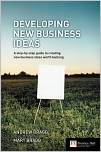| |||||
• polskie
• Zamów informacje o nowościach z wybranego tematu • kontakt |
DEVELOPING NEW BUSINESS IDEASBRAGG A., BRAGG M.wydawnictwo: PEARSON, 2005, wydanie Icena netto: "... the vast numbers of books devoted to the subject... have done little to
improve the situation... Andrew and Mary Bragg's Developing New Business Ideas might just
be the book to change much of this... If this book can help investors and would-be
entrepreneurs in this area it will do not just them, but also the economy as a whole a
great service." At some time in their life, almost everyone in business has an idea for a new enterprise. The idea might be sparked by dissatisfaction with an existing product, experiencing something new while traveling or simply finding that nobody in the market is serving your particular need. The idea could be for a new venture for your business to launch, or for new business of your own. But most ideas remain just that: ideas. We struggle to develop them, wondering if they will work, why nobody has already thought of them and how we could ever turn them into a profitable reality. How do you take a promising thought and develop it into an enterprise worth backing? That is the question that this book sets out to answer. In Developing New Business Ideas, Andrew and Mary Bragg provide a practical guide to creating, shaping, evaluating, refining and implementing new business ideas. The book demonstrates that it is within absolutely everybody's power to take the first germ of a business idea and to systematically creatively challenge and commercially develop that idea into a viable business opportunity. Using a practical four-step creative process, Developing New Business Ideas offers a wide-range of hands-on, how-to-actually-do-it techniques to help you add value and viability to your original idea. It will also introduce you to the experiences of a range of today's successful entrepreneurs, enabling you to learn from the creative lessons that they learned as they built their businesses. Supported by its own set of online tools, Developing New Business Ideas is an imaginative and interactive companion to converting creativity into successful enterprise. "Having had your bright, fresh, original idea, the really hard part is turning it
into successful reality. By detailing four structured steps to developing saleable
products or services from that first idea, this excellent and imaginative guide
significantly simplifies that task. Essential reading for all would-be
entrepreneurs". Features
Mary Bragg worked in marketing with GlaxoSmithKline, before undertaking management consultancy with PricewaterhouseCoopers, both in the UK and internationally. Her professional qualifications include a Masters Degree from London University. She combines independent management consultancy with a university career as Principal Lecturer on entrepreneurship and creativity. A Fellow of the Royal Society of Arts, Mary was a founding trustee of the Academy of Enterprise. Her earlier book, Re-inventing Influence, won the Management Consultancies' Association award for best management book of the year in 1996. Andrew Bragg's wide-ranging business career includes general management and marketing roles in the UK and mainland Europe across commercial and not-for-profit sectors. His chief executive roles have covered the multimedia, print and packaging sectors and have involved a number of entrepreneurial start-ups. A graduate of Trinity College, Cambridge, Andrew also gained an MBA from Cranfield University. Contents Chapter 1: The importance of developing strong ideas James Dyson - using the idea development process to clean up Chapter 2: Applying creativity to the idea development process Phil Knight and NIKE - combining logic and intuition into record-breaking success Chapter 3: Step One - seeking and shaping opportunities Amazon.com - shaping the internet opportunity Chapter 4: Step Two - generating new ideas Howard Head - an analogical approach to business success Chapter 5: Step Three - evaluating and selecting ideas Karan Bilimoria: brewing the criteria to achieve the "big one" Chapter 6: Step Four - planning for implementation Frederic Smith - overcoming the obstacles to Fedex Appendices Paperback, 288 pages Księgarnia nie działa. Nie odpowiadamy na pytania i nie realizujemy zamówien. Do odwolania !. |


